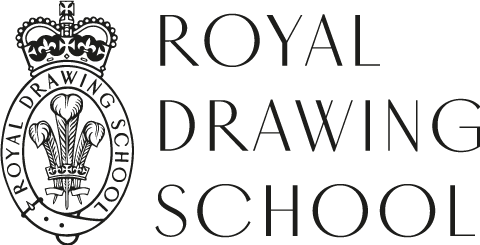Drawing Year Alumnus Geraint Ross Evans: Artist-in-Residence at BBC Radio 6 Music Festival
Geraint Ross Evans is an alumnus of The Drawing Year and a tutor at the School on our public courses and Young Artists programme. Here he tells us about his experience as Artist-in-Residence at BBC Radio 6 Music Festival and some of his other recent projects as a freelance artist in his hometown of Cardiff.

Father John Misty at St David's Hall
Can you tell us how you came to be involved in the BBC 6 Music Festival 2022?
I was contacted by Cardiff Council who asked if I wanted to do some live drawing at an upcoming music festival. They wanted someone who could make fast drawings at and of gigs. The job was confirmed only a few days before the news broke that this year's 6 Music Festival was coming to Cardiff. I don’t think the council really knew what the residency would look like, but they had confidence that I could make drawings in this kind of situation and within a very short time frame. I'd been working at a hospital a few months prior, where I was regularly drawing on site in challenging circumstances.
What did the role of Artist-in-Residence at the festival involve?
I was making drawings at the gigs, mainly to give a glimpse of the performances from the crowd. 6 Music has a huge following and the festival sells out almost immediately so there are lots of disappointed fans out there. The BBC do a great job of broadcasting the festival, but the drawings bring something more personal. They were mainly shared via social media and I actually got to keep the originals, so I’ll hopefully do a little show at some point in the future.

Harry Jowett at Porters (part of the fringe festival)
What kind of work did you produce there?
Drawings from the crowd, capturing the artists and the venue; my view. Each drawing was made during the performance, and aims to capture the feel of each particular set. Usually I’d start with the musicians and see where it led me, following a kind of hierarchy of reportage until the last notes rang out and my time would be up. The drawings got larger and more ambitious as the festival went on and I got faster and more confident.
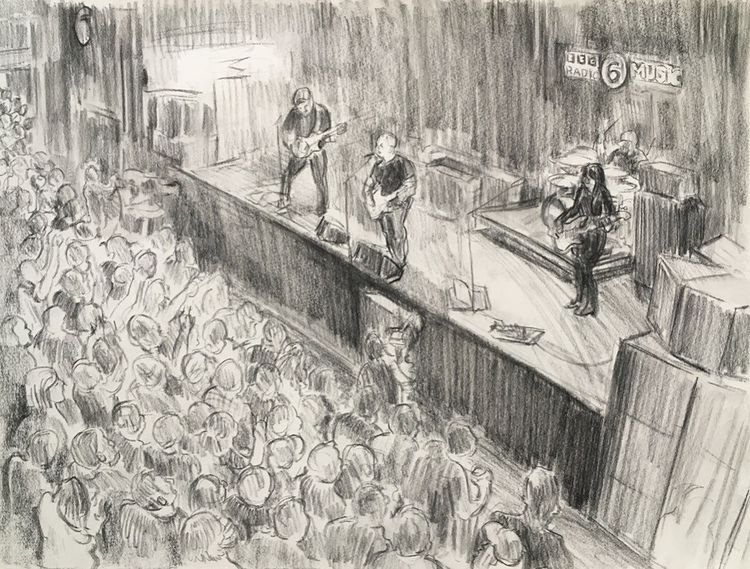
Pixies at The Great Hall
How did you find the experience?
Tricky, fun and fast. As you probably can guess, the artists were constantly moving around the stage, so capturing them became a bit of a chase. The best drawings, I think, were when I was able to let go and immerse myself in the experience, a sort of flow state with the music - as cheesy as that sounds!
I would be out at gigs until 1am most nights, then up early trying to get the finished drawings photographed and sent to the BBC social media team, then off again, usually rushing out around midday to get to the first gig of the day. Needless to say, I didn’t get much sleep! The festival happened to land on my birthday; I saw it in walking home alone after the Idles/Pixies gig with a big smile on my face, that was pretty special. I’ve been a fan of 6 Music for years, so I was thrilled to be asked to do something like this, especially in my hometown.
You recently coordinated a community drawing project, with members of the public responding to Cardiff. Can you tell us about that?
Again this was commissioned by Cardiff Council, who are always looking for innovative ways to engage with the community. They were aware of a couple of public artworks I have on display in South Wales and offered up a wall space at Cardiff Central Library to facilitate an artwork with the community.
We sent a call out looking for volunteers to get involved. They were asked to collaboratively create a public artwork that embodied their experience of Cardiff city centre, to give a meaningful insight into life as a resident and share their points of view through drawing. The volunteers were from all walks of life, some were new residents, others were home-towners. There was a wide range of drawing levels, from completely new, to one person who was studying Illustration. We had a broad age range that spanned the generations from GCSE school students, to retirees.
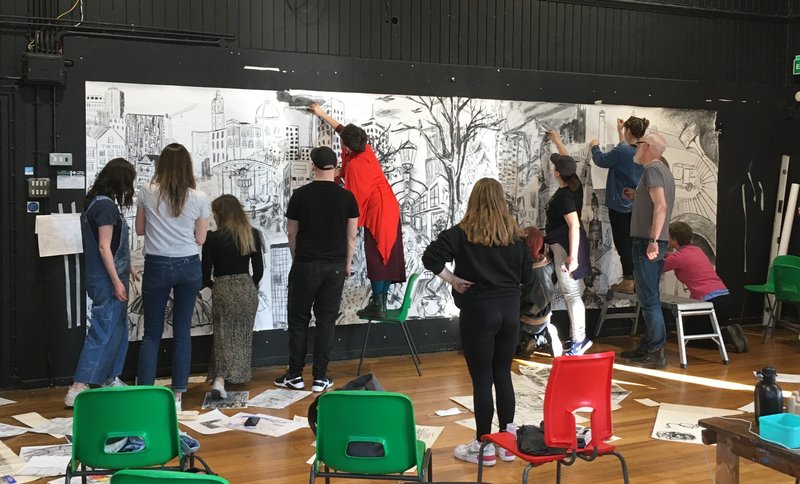
I organised five two-hour drawing workshops on Thursday evenings, plus a sixth day making the large-scale drawing. The workshops paired developing drawing skills with making observational drawings that could be used to make the mural. We drew in the city most weeks. We always started with a discussion and looked at artists' works across a number of themes, such as visual storytelling or creating a sense of place, then we’d see how these inspired us to think about the city. We talked a lot about landmarks, and we found that these were different to the tourist postcards, much more personal and rooted in lived experience.
The final drawing is a composite of all their work, along a huge panoramic sheet. It has since been digitally documented and installed permanently in the library.
You have an upcoming exhibition: Front Lines: A 21st Century Response to Stanley Spencer's First World War Paintings. What kind of work have you produced?
I was invited to Grange University Hospital in Cwmbran, South Wales almost a century after Stanley Spencer was commissioned to create a chapel to honour the soldiers of the First World War. The residency and subsequent mural was commissioned by Studio Response in partnership with the Aneurin Bevan Health Board.
My sketches cover a time when the hospital was dealing not only with the usual medical needs of its patients, but also the extra demands brought about by the coronavirus pandemic. I've documented patients receiving treatment, and nurses going about their duties. The idea is that the drawings are a modern-day response to the art Stanley Spencer created after working as a medical orderly, and then serving as a soldier during the First World War.
I have also included drawings from some of Spencer’s murals at Sandham Memorial Chapel. In sketching Spencer’s work, I feel I’m having a conversation with him as an artist. It gives me a really good insight into how he made his paintings, so the drawings I make are my link with Spencer.
What was it like to draw patients and staff in the hospital, especially during such a difficult time?
I didn't have access to the covid wards, for obvious reasons. They were cleverly set up in a way that meant covid patients took a completely different route through the hospital. The staff were so calm, professional and downright impressive that after a few visits they almost had me convinced that it was all quite normal.
In terms of drawing vulnerable and ill people, that was sometimes difficult. On a practical level, there's no 'spare' space in a hospital, and I was always nervous of getting in the way. Luckily all the staff I met were very supportive and curious about the project. They were integral in helping me forge relationships with patients and provide me with space and consent. The staff in the maternity ward asked a number of new mothers if they wouldn't mind being drawn for the project, so I was able to meet and draw a new family with their blessing. That was a really nice experience as I was recording a positive monumental moment in their lives. Later that same day, I was downstairs in neonatal intensive care with another new mum and her child undergoing ultraviolet conditioning in an incubator, which was much more intense but still incredibly moving.

On one hand I was removed emotionally because the people I was drawing were strangers but on the other hand, the struggles, pain and worry you witness is human and does obviously affect you. At the hospital, the fact I'd been given this incredible responsibility and trust to record what I was seeing would often help me to focus on the task at hand, as I didn't want to waste a moment. It was back in the studio, working large-scale, that all those experiences came bubbling to the surface and I was able to depict some moments that I couldn't draw in person.
Do you have a favourite piece of work in the exhibition?
My drawing 'The Map and the Territory' was inspired by Spencer’s Map Reading mural panel which can be seen at Sandham Memorial Chapel. I loved the play between the bird’s eye view you get of the map with the soldiers surrounding it.
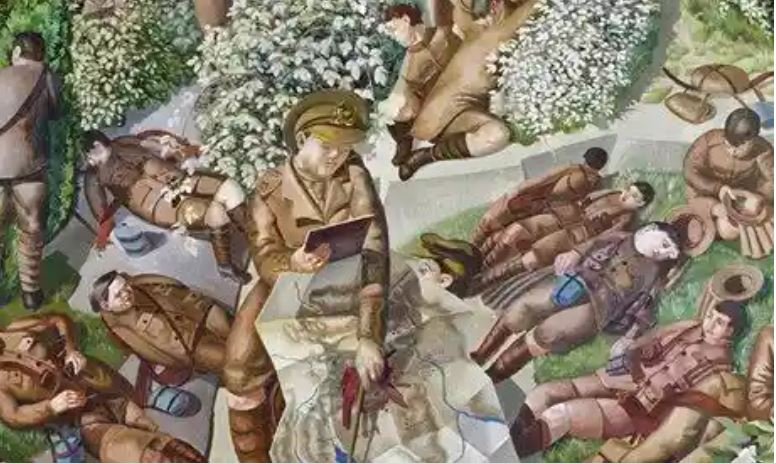
Detail from Map-reading by Stanley Spencer at Sandham Memorial Chapel, Hampshire. Photograph: National Trust Images/John Hammond
I began to imagine a map that was fully immersed within the territory it transcribes. My response uses Cardiff as the subject. Complete with a self portrait, I present an OS map that becomes a kind of shelter for the people of the city who sleep underneath. The scene is enclosed by a circular 360 panorama, the boundaries of our shared world, seen from upon a real place, a greened-over landfill site called Grangemoor in Grangetown.
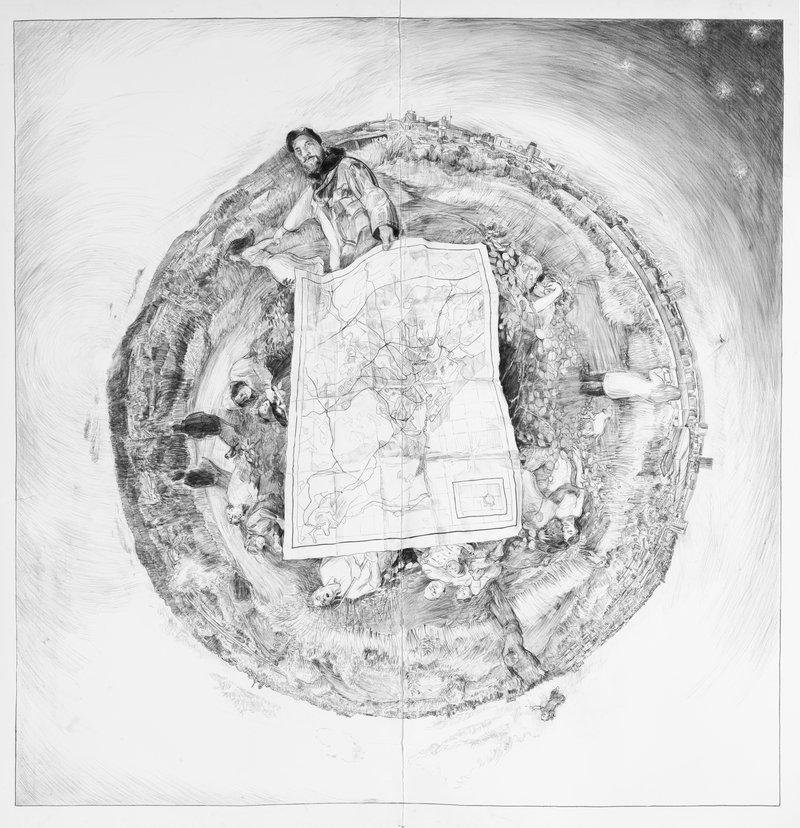
This work will be reproduced as an external artwork in the grounds of the chapel and will form part of my upcoming exhibition at National Trust Sandham Memorial Chapel in Burghclere, England.
How have you found that these kind of opportunities arise – is there any advice you can give to emerging artists?
The exciting thing about an art career is that there are infinite ways of doing it, echoing the very making of art itself, as it should. It’s definitely a slow game though. Just as it takes a long time to build up a body of work, it takes time to build relationships.
Try to stay open minded about what is possible and dig out your own way. My practice has lots of different elements that have each played a part in funnelling me along my particular path. For example, my desire to make large-scale images together with not being from an artistic background in the sense of class and upbringing, has forced me to consider the kind of spaces I can show my work in and the kind of people I want to see it. Commercial galleries haven’t been an obvious route for me, which has challenged me to think a lot about public engagement. I now have two permanent public artworks on display in South Wales, one at The Grange Hospital in Cwmbran and another at a community hub at the National Trust's Tredegar House in Newport.
These large works are always informed by observational drawings which means I can be fairly visible out and about with a drawing board; I met the council workers who commissioned the community mural this way. In 2019 I spent time drawing volunteer community groups for a project about visualising pathways to a better future. They organised a local tree planting and I went along to draw, and we've stayed in contact ever since.
Geographical location can also play a role. If I was in London and 6 Music Festival came looking for the Artist-in-Residence gig, I would have been much less visible in the sea of artists who would also be perfect for that role. That’s not to say there are not a lot of world class artists in South Wales, there really are, but I stand out a bit more there as an artist specialising in drawing, than I would in London.
Do you feel that The Drawing Year helped to increase professional opportunities like this for you?
The Drawing Year gave me so much, from practical skills, to ways of thinking, opportunities and also importantly, it nurtured confidence in myself and my practice. Even though I was already making and exhibiting in a pretty vibrant DIY art scene in South Wales, I found it difficult to orientate my interest in making images within what seemed to me at the time, a very performance and media based art scene. The seven years before the Drawing Year, I supplemented my practice by working in a chip shop - I drew an awful lot on newsprint!
Since the Drawing Year, I’ve been incredibly lucky to continue to work with and for the School. I’ve been on artist residencies to Scotland and Madrid, and I was a technician and studio supervisor. I particularly benefitted from my experience as a tutor trainee, and teaching on the Young Artists Programme during the year that followed, which helped me to develop a teaching practice. I now teach regularly on the School's public courses. All this experience has made applying for funding, projects or residencies much more attainable, which has been instrumental in developing a career back home in my beloved Caerdydd (Cardiff).
You can see Geraint's exhibition Front Lines: A 21st Century Response to Stanley Spencer's First World War Paintings at Sandham Memorial Chapel from 11th June - 25th September, with a preview on Saturday 11th June 4-6pm.
